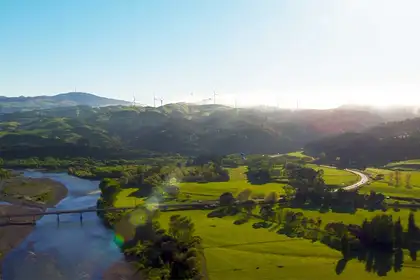
The Manawatū River catchment will feature in the research project.
Modern environmental mapping systems can provide almost everything there is to know about the environment, except what Māori know about it, which is why academics at Massey University have come up with a project to try to meld mātauranga Māori (Māori knowledge) with the latest geographic information systems.
The He Tātai Whenua: A Te Ao Māori landscape classification project has received nearly $3 million dollars in funding from the Ministry of Business, Innovation and Employment’s Endeavour Fund.
It will use this money to create new ways of translating Māori environmental expertise so it can be added to existing systems. These systems, known as geographic information systems, allow us to understand our physical environment by combining layers of geographic data such as land type, soil type, elevation, and other vital data like waterways, roads and developments.
The research proposes to develop methodologies to translate Māori environmental expertise, so that new data layers can be added into existing systems.
Associate Professor Jonathan Procter, Muaupoko, says the project will improve environmental reporting, decision-making and monitoring.
“The historic and contemporary value of mātauranga Māori is recognised and even required by legislation but we don’t have the tools to make effective use of mātauranga Māori in environmental science and that’s what we propose to develop.
There are challenges with integrating mātauranga Māori, which is rich in qualitative information from oral and written history, and western science, which relies on quantifiable data. But Mātauranga Māori can provide us with more than 1000 years of intergenerational environmental experience.
It will more effectively support the identification of hazards to our natural ecosystems by defining criteria and creating datasets of landscapes that recognise inter-relationships and inherent vulnerabilities to land use changes during the occupation Māori have experienced and documented.”
The project will focus on the Manawatū catchment and will then be used to develop the protocols required to extend the Māori Landscape Classification GIS to the rest of New Zealand.
Quantifying cultural knowledge
It is a big task to integrate the rich qualitative information Māori have built up over generations and contained in oral histories, waiata, archives, carvings and even in place names.
Massey lecturer Hone Morris, Ngāi Te Rangitotohu, Ngāti Mārau, a specialist in te reo Māori, will face the first problem - how to transform written and oral histories into the digital world.
“It’s a challenge, otherwise someone would have done it already. Using the terminology that our ancestors used for the Manawatū river for example, and turning that into something that can be digitally represented is something I have been mulling over for many years.”
Mr Morris says Māori expert interpretation of landscape features is well recognised but difficult to integrate into a scientific context.
“Data of this kind is still treated as anecdotal or qualitative and, as a result, lacks impact in environmental management and decision-making.”
Given the depth of Māori knowledge needed for the project, the iwi and community research will be carried out by six researchers from each of the six main iwi groups in the Manawatū catchment. This will help create a unique project team with a broad range of expertise, ranging from Māori art to mathematical modelling. Mr Morris says, “Our research team is predominantly Māori, meaning that the research will be carried out by Māori, with Māori, for the benefit of all New Zealand.”
The project will work closely with the Manawatū River Leaders Forum and forum chair Richard Thompson says the work is critical. “We have struggled to gather sufficient information about aspects of mātauranga Māori, tikanga and kaitiakitanga. The issue is not that the information is not known, rather that it is not accessible or easily incorporated into the usual frameworks for information and science…I am sure that the research will not only benefit work in the Manawatū; the same issues are faced throughout New Zealand and work to rectify this situation is long overdue.”
Rangitāne o Tamaki Nui a Rua chair Henare Kani says, “This work will be of great benefit to Rangitāne and help build on what we are currently doing and grow our ability to achieve our strategic opportunities in this field.”
It is expected the tools developed by the project to enable indigenous knowledge to be integrated into scientific systems will have applications for other cultures around the world.